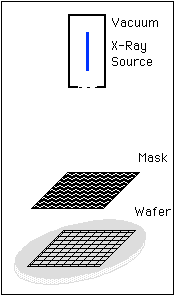Description:
X-Ray lithograpy is a variation of light lithography tecniques using short wavelength X-Rays. The substrate, coated with a x-ray resist, is exposed to a source of x-rays through a x-ray mask.

Advantages:
- Fast process
- High resolutions of ~ .5 µm
- Not affected by organic defects in mask
- Reduction in diffraction, reflection, and scattering effects
- Solves depth of focus problem
- High aspect ratio
Disadvantages:
- Shadow printing
- Lateral magnification error
- Brighter x-ray sources needed
- More sensitive resists needed
- Difficult fabrication of x-ray mask
X-Ray Resists:
These are materials which exhibit changes, whether physical or chemical, due to exposure to x-ray radiation. X-ray resists must be both sensitive to x-ray radiation, and be resistent to the etching stage later in the lithography process. Traditional x-ray sources, x-ray tubes, and laser plasma x-ray sources require very sensitive resists for satisfactory quality. On the other hand, electron and photoresists can be exposed by synchrotron radiation.
Positive Resists
In order to appropriately expose positive x-ray resists, the exposure must be lengthy.
Negative Resists
Sensitive negative resists still suffer from low resolution, and must be prepared using multiple processing steps.